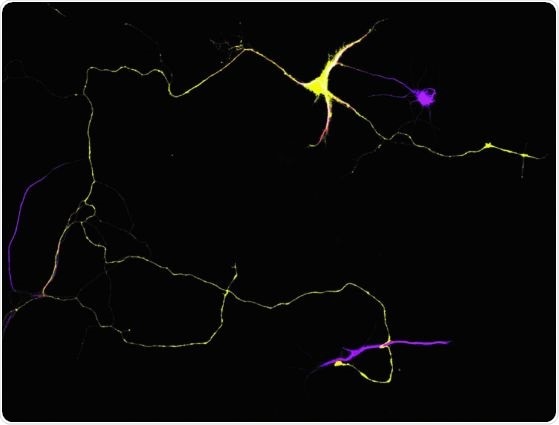Nov 19 2020
At Tufts University School of Medicine, scientists have identified a molecular mechanism that leads to a “traffic jam” of enzymes moving up and down neuronal axons, resulting in the accumulation of amyloid-beta—a main feature and cause of Alzheimer’s disease.

Mouse hippocampal neuron expressing a green fluorescence protein (GFP, yellow) making synaptic contacts with other neurons in cultures stained for microtubule-associated protein 2B (MAP2B, magenta). Image Credit: Tufts University School of Medicine.
The enzyme, BACE1, is backed up, which makes the axons to clog and swell due to the increased production of the toxic amyloid protein.
Published recently in Science Translational Medicine, the study notes that a human mutation more common in African American patients with late-onset Alzheimer’s induces a traffic jam of BACE1 in axons. The identification of this mutation is a crucial step in gaining insights into the fundamental molecular mechanisms of the disease and offers a potential strategy for early diagnosis and targeted treatments.
In individuals with Alzheimer’s disease, the onset of symptoms happens about 20 years after the first changes start to develop in the brain, making therapeutic intervention extremely difficult.”
Giuseppina Tesco, Professor of Neuroscience, Tufts University School of Medicine
“So, we wanted to identify the mechanisms leading to the swelling of axons during the pre-symptomatic phase of Alzheimer’s disease, which could in turn provide a way to detect the disease early and possibly treat it more effectively,” added Tesco, who is the senior and corresponding author of the study.
Previously, Tufts researchers discovered a gene, Gga3, that helps control the traffic of BACE1, or beta-site APP-cleaving enzyme 1, along the axon. In this study, the team identified that mutation or missing of the Gga3 gene in mice causes their brains to present the same unique traffic jam of BACE1 in swelling axons found in the postmortem brains of early-stage patients with Alzheimer’s disease.
The team discovered that disruption of the Gga3 gene causes slows down or stops the traffic of BACE1 and other proteins along the axon. In addition, it was observed that a missing or mutated Gga3 causes a severe accumulation of BACE1 in the axon, leading to axonal swellings both in cultured neurons and in a mouse model of Alzheimer’s disease before amyloids are deposited.
In several clinical trials, BACE inhibitors administered to patients suffering from advanced disease with considerable accumulation of amyloid beta protein and neuronal damage have been unsuccessful. The team questioned if administration of the inhibitors at the preliminary stages of disease might be more effective.
The inhibitors were found to inhibit swelling of axons in mice and even enhance the two-way flow of BACE1. Their findings indicate that earlier administration of BACE1 inhibitors could be highly effective at decelerating the accumulation of amyloid beta protein.
The team used datasets from the National Institutes of Health’s National Institute of Mental Health and the Alzheimer’s Disease Neuroimaging Initiative and found that mutations in Gga3 were more prevalent in African Americans diagnosed with Alzheimer’s disease compared to other populations.
Despite the small sample size, the team hopes that the results of this study may offer a case for determining early-stage interventions and treatments for this group of patients.
Our study provides a possible molecular explanation for the prevalence of axonopathy during the early stages of Alzheimer’s disease, before the formation of amyloid plaques. The mutation allowed us to determine that axonal alterations can be caused by accumulation of BACE1. Now an area of focus could be inhibiting BACE1 to prevent early axonal damage and perhaps this could also slow the development of amyloid plaques leading to disease.”
Giuseppina Tesco, Professor of Neuroscience, Tufts University School of Medicine
According to the team, the occurrence of neurofilament light chain (NfL) in blood plasma is an indicator of axonal damage, and could help determine the ideal timing to use BACE inhibitors to avoid or decelerate the progression of Alzheimer’s disease during its early pre-symptomatic stages.
Source:
Journal reference:
Lomoio, S., et al. (2020) Gga3 deletion and a GGA3 rare variant associated with late onset Alzheimer’s disease trigger BACE1 accumulation in axonal swellings. Science Translational Medicine. doi.org/10.1126/scitranslmed.aba1871.